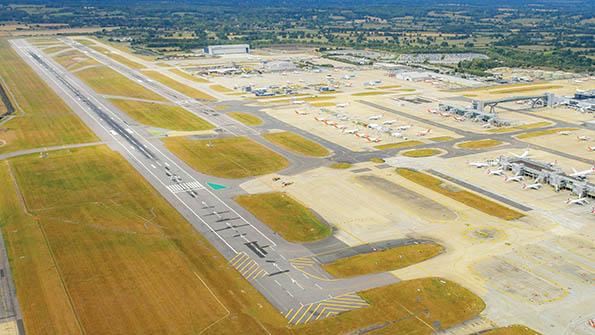
London Gatwick Airport currently uses its shorter, northern runway primarily as a taxiway but is proposing to develop it into a fully operational departure runway.
For decades, London Gatwick Airport (LGW) has operated in the shadow of the capital’s aviation hub, London Heathrow (LHR).
Heathrow has traditionally been favored by business travelers, both for its proximity to the city center—it lies about 12 miles to the west—and for the plethora of connections available through it.
Still, Gatwick has for some time been the world’s busiest single-runway airport. Now it wants to change that reputation by opening a second runway to significantly increase the number of passengers it serves.
Located some 25 miles south of London, Gatwick had a reputation for many years as a “bucket-and-spade” airport, as it mainly catered to short-haul flights for holidaymakers heading to Mediterranean beach resorts. LCC easyJet is the largest operator at Gatwick and nine of its top 10 destinations are European.
However, that flight profile is changing. In August, the airport announced its 50th long-haul route (Ethiopian Airlines to Addis Ababa), although many of these are still leisure-related, notably to Dubai and the Caribbean.
Still regarded by many airlines as London’s second-choice airport—several have used it to get a foothold in London, then switched to Heathrow when rare slots became available—Gatwick handled 46.6 million passengers in 2019 before the pandemic struck.
In 2022, numbers were still significantly below that figure, at 32.2 million, but climbing. The airport told ATW it was unable to give a forecast for the number of passengers it would handle in 2023.
However, given the arrival of British Airways’ lower-cost short-haul subsidiary BA EuroFlyer and the growth of low-cost, long-haul specialist Norse Atlantic Airways, together with the steady increase in long-haul destinations, passenger numbers can be expected to be nearing 2019 levels by the end of this year.
Those numbers have made Gatwick look at ways to increase its throughput. A single runway poses difficulties in the event of any mishap. Like Heathrow, it “runs hot” and anything that puts the runway out of action can have knock-on effects for several hours.
To improve its resilience, Gatwick has filed plans with UK planning authorities for a second runway. The Northern Runway Project involves bringing a standby runway into use for departing flights alongside the existing main runway. The airport is currently limited to using the northern runway as a taxiway or when the main runway is out of use.
The airport declined to speak with ATW, but in a written statement a spokeswoman said that it intends to move the northern runway’s centerline 12 m (39 ft.) to the north to allow greater clearance from the main runway.
The project will also include a host of related works, including reconfiguration of taxiways, pier and stand amendments (including a proposed new pier) and extensions to the airport’s two terminals.
The new runway will have limitations. The existing main runway is 3,316 m long whereas the northern runway is only 2,565 m in length and will not be extended as part of the project.
Partly for this reason, it is planned to accommodate aircraft up to the size of an Airbus A320 or Boeing 737 and will handle departures only.
“If approved, our plans would allow dual operations of our main runway and northern runway, aligning with international safety standards,” the spokeswoman wrote. “All arriving flights would use the existing main runway, as this has an instrument landing system (ILS) whereas the northern runway is a non-instrument runway. Departing flights would be shared between the existing main runway and the northern runway, with the northern runway being used for smaller aircraft.
“There would be controlled dependency between the two runways to enable safe crossing of the northern runway by arrival flights.”
At present, the single runway can operate up to 55 movements per hour, and in 2019 it handled a total of 283,000 movements. The added capacity from the new runway would enable Gatwick to handle 382,000 commercial air traffic movements by 2038, with 75.6 million passengers able to pass through the airport—a major increase compared with current capacity.
While Gatwick would remain short-haul dominated, a second runway would allow more long-haul traffic.
“If you can increase your throughput, which is your bread and butter, that will allow you to accept more long-haul services on the main runway,” said UK-based director at JLS Consulting John Strickland. “It’s definitely complementary.”
He did not believe that developing the second runway at Gatwick is a substitute for greater capacity at Heathrow, as the latter is more focused on long-haul services. It also remains the favored airport for higher-margin business travelers as it has the network structure to offer more connections, whereas Gatwick is more orientated toward point-to-point services.
While environmental considerations surrounding the expansion of any airport have taken a much more significant role in recent years, “I’ve always felt that Gatwick would be much easier [than Heathrow] because it’s in a much more rural setting that reduces the effect of the noise footprint,” Strickland said. Departing Gatwick aircraft climb out over the countryside and the English Channel is a relatively short distance away.
“I think they have less of a challenge than Heathrow and they would have the argument that, with Gatwick’s emphasis on short-haul flights, they have more new-generation aircraft operating that are quieter and more fuel-efficient,” he said.
The proposed project also has the advantage of being largely contained within the airport’s existing boundaries, although there will be some highway adjustments just outside the perimeter.
This is in contrast to Heathrow’s proposed third runway, which would entail razing a village alongside the airport and diverting London’s main orbital motorway, which would have to be moved 150 meters to the west and buried in a tunnel under the new runway, at vast cost in terms of money and disruption.
“As part of our plans we are working with relevant highway authorities to redesign and improve local roads around the airport to mitigate the impact of airport traffic on local road users,” Gatwick said in its statement to ATW.
Gatwick’s proposals have now been submitted to the UK’s Planning Inspectorate. If all goes according to plan, construction could start in 2025 and the new runway being operational by the end of the decade.
ENVIRONMENTAL CONCERNS
The timeline will also depend on the scale of the now-inevitable environmental challenges to any airport expansion in the UK.
“The planet cannot afford this expansion,” local protest group Communities Against Gatwick Noise and Emissions (CAGNE) told ATW. “We are horrified that a government Planning Inspectorate would agree to a second runway when it impacts the well-being and house value of so many residents, as well as the planet.”
Major environmental lobby groups such as Greenpeace are also unhappy with the planned expansion and the project will almost certainly end up in court.
Despite those concerns, some believe Gatwick makes a compelling case.
“I think from a commercial perspective, it should be a pretty strong business case,” Becrom Basu, a partner in the transport practice at consultants LEK, said. “Gatwick is full and there still seems to be a strong demand for leisure flying, which is mainly what Gatwick is serving. I would expect the numbers would work out well. And compared to the [Heathrow proposal] the CapEx is quite small. If you compare it with the third runway at Heathrow, this is much more practical, in several ways.”
Pre-pandemic, Gatwick’s main runway was running at 90%-plus in terms of utilization.
“Airports are quite innovative in terms of squeezing extra flights but, like Heathrow, it comes at the price of potential disruption,” Basu said regarding the knock-on effects of any problems on the main runway.
Basu said it is difficult to predict what level of opposition the runway plan might trigger.
“Personally, I feel restricting capacity at London airports is a bit of a false economy when it comes to saving the planet,” he said. “People will just fly to [Paris] Charles De Gaulle, Frankfurt or Amsterdam and hub through there. I think forcefully restricting capacity isn’t likely to work. If it goes ahead, there will probably need to be some concessions on some aspects, whether it’s cutting out night flights completely or making some commitment to modal share mix—for example, a minimum number of people coming in by train, or some aspect of travel management around the airport.”
Gatwick has a rail station with a frequent service from central London adjacent to its South Terminal, but most passengers still arrive by motor vehicle.
The airport has measures in place to manage the impact of nighttime noise. The UK government limits the number of flights between 11:30 p.m. and 6 a.m. that the airport is allowed to operate per year. The limits are set at 3,250 over the winter period and 11,200 over the summer, when holiday traffic is greater. Gatwick authorities add that both runways would not be used routinely between 11 p.m. and 6 a.m.
“We understand some people may have reservations about our plans,” the airport wrote. “We are working with local councils and other interested parties to provide as much information as possible about our plans, and provide evidence and reassurances where necessary.”
What impact might Gatwick’s new runway have on the case for Heathrow’s proposed third runway?
“That’s an interesting question. In the medium term, it might be compromised to a certain extent. I think, though, that the case for Heathrow is more about connectivity for the country,” Basu said. “I don’t think Gatwick’s second runway will lead to more connectivity; I don’t think it will be a game-changer. You may get a few extra routes, but business flyers prefer to fly out of Heathrow.
“Gatwick has a natural catchment area south of London, but it’s mainly for leisure flights. Heathrow has a much richer catchment area with the M4 motorway corridor”—along which many high-tech companies have settled—”and central London.”
